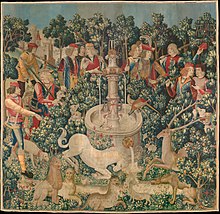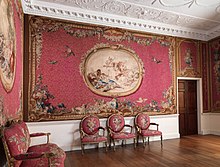Tapestry

Tapestry is a form of textile art, traditionally woven by hand on a loom. Tapestry is weft-faced weaving, in which all the warp threads are hidden in the completed work, unlike most woven textiles, where both the warp and the weft threads may be visible. In tapestry weaving, weft yarns are typically discontinuous; the artisan interlaces each coloured weft back and forth in its own small pattern area. It is a plain weft-faced weave having weft threads of different colours worked over portions of the warp to form the design.[1]
Tapestry is relatively fragile, and difficult to make, so most historical pieces are intended to hang vertically on a wall (or sometimes in tents), or sometimes horizontally over a piece of furniture such as a table or bed. Some periods made smaller pieces, often long and narrow and used as borders for other textiles. European tapestries are normally made to be seen only from one side, and often have a plain lining added on the back. However, other traditions, such as Chinese kesi and that of Pre-Columbian Peru, make tapestry to be seen from both sides.[2] Most weavers use a natural warp thread, such as wool, linen or cotton. The weft threads are usually wool or cotton but may include silk, gold, silver, or other alternatives.

Tapestry should be distinguished from the different technique of embroidery,[3] although large pieces of embroidery with images are sometimes loosely called "tapestry",[4] as with the famous Bayeux Tapestry, which is in fact embroidered.[5] From the Middle Ages on European tapestries could be very large, with images containing dozens of figures. They were often made in sets, so that a whole room could be hung with them.

In late medieval Europe tapestry was the grandest and most expensive medium for figurative images in two dimensions, and despite the rapid rise in importance of painting it retained this position in the eyes of many Renaissance patrons until at least the end of the 16th century, if not beyond.[6] The European tradition continued to develop and reflect wider changes in artistic styles until the French Revolution and Napoleonic Wars, before being revived on a smaller scale in the 19th century.
Terms and etymology[]

In English, "tapestry" has two senses, both of which apply to most of the works discussed here. Firstly it means work using the tapestry weaving technique described above and below, and secondly it means a rather large textile wall hanging with a figurative design. Some embroidered works, like the Bayeux Tapestry, meet the second definition but not the first. The situation is complicated by the French equivalent tapisserie also covering needlepoint work, which can lead to confusion, especially with pieces such as furniture covers, where both techniques are used.
According to the Oxford English Dictionary, the earliest use in English was in a will of 1434, mentioning a "Lectum meum de tapstriwerke cum leonibus cum pelicano".[7] They give a wide definition, covering: "A textile fabric decorated with designs of ornament or pictorial subjects, painted, embroidered, or woven in colours, used for wall hangings, curtains, covers for seats, ..." before mentioning "especially" those woven in a tapestry weave.[8]
The word tapestry derives from Old French tapisserie, from tapisser,[9] meaning "to cover with heavy fabric, to carpet", in turn from tapis, "heavy fabric", via Latin tapes (gen: tapetis),[10] which is the Latinisation of the Greek τάπης (tapēs; gen: τάπητος, tapētos), "carpet, rug".[11] The earliest attested form of the word is the Mycenaean Greek